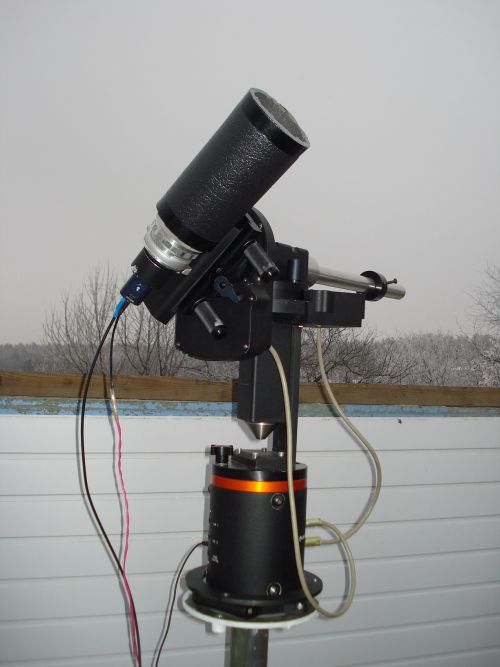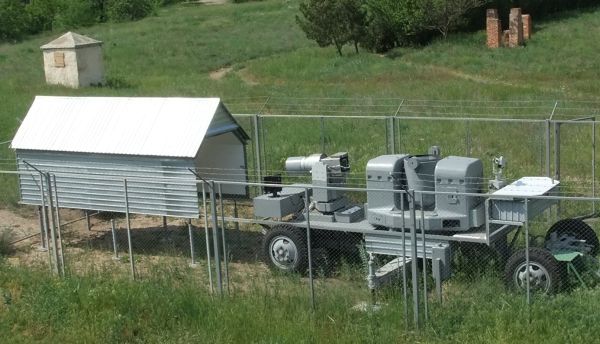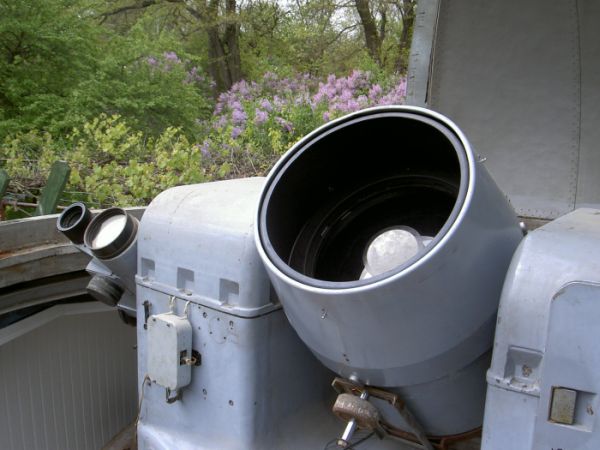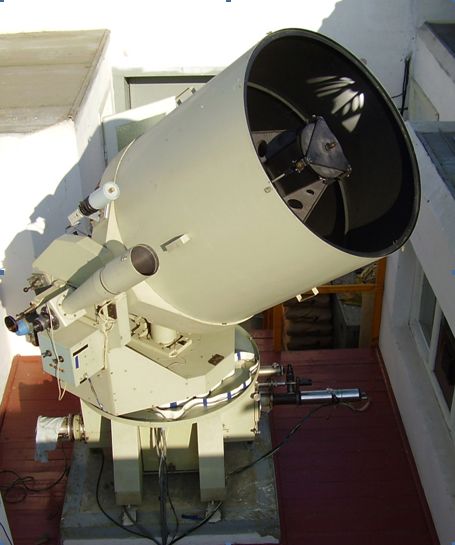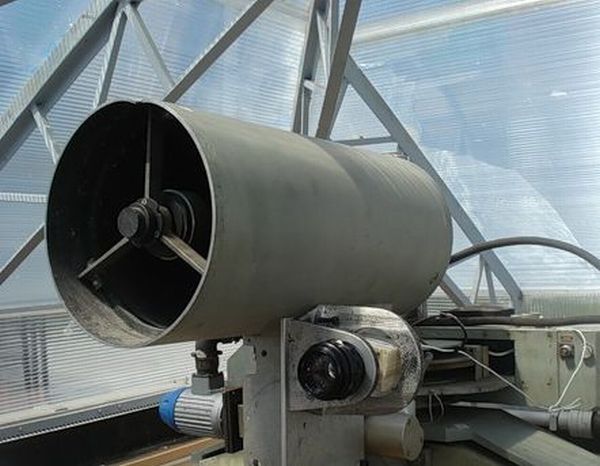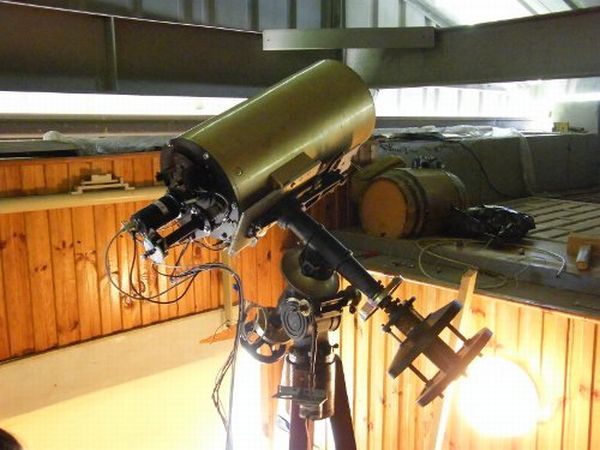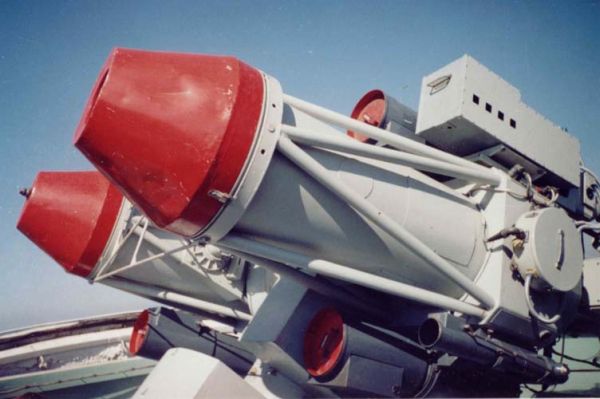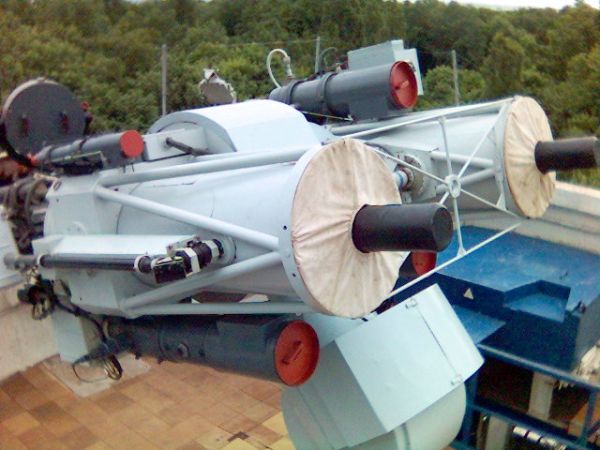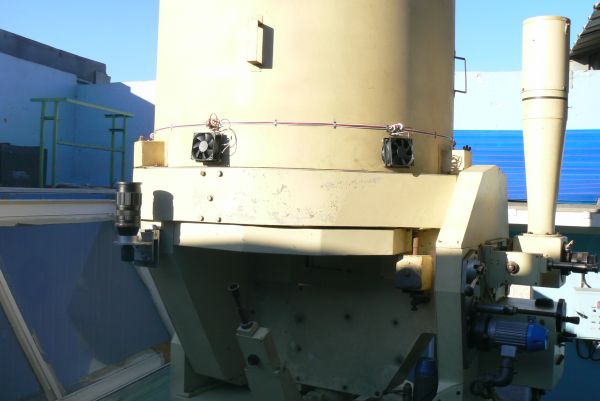Network of Optical Stations
The main astronomical observatory of Ukraine takes part in regular observations using a telescope redesigned on the base of Celestron CGE mount. The telescope was installed at Lisnyky Station of the Astronomical Observatory of Kyiv National University named after Taras Shevchenko. Optical and electronic system consists of objective Helios-40 and CCD camera WAT 902H (WATEC).
Typical weather conditions:
- number of clear night a year is 90±10.
Satellites in the low Earth orbit (LEO) can be observed in orbit height of 200 to 2000 km.
Orbit inclinations are not limited.
Observations are possible:
- in azimuth range of 0º to 180º;
- at zenith distance of up to 80º.
Technical features are the following:
- altitude-azimuth mount;
- objective Helios-40, ( D=
- high-sensitivity CCTV camera WAT-902H, 25 frames per second;
- field of view - 4.3º × 3.2º;
- limiting stellar magnitude for LEO satellites is 11m.
Synchronometer and a standard of frequence and time are synchronized with GPS receiver.
The telescope is in full working condition.
The software packages are available for:
- managing the observations: Plan_CU, Video, Control, Motion;
- raw image processing (filtering): CCD, Astrometrica, satellites.
Measured parameters:
- equatorial coordinates of objects in Earth's orbit (OEO).
Results of astrometric measurements are compiled in two formats:
- *.mea format;
- another special format.
The telescope is able to measure equatorial coordinates, angular speed, type of the OEO.
Maximum measurable angular speed of LEO satellite is up to 1.5°/s.
The standard error of equatorial coordinates is in the range of 5" to 10" for the LEO satellites.
Errors of target designation for the LEO satellites should not exceed 2 minutes of time, and must not be more than 1.5° in both azimuth and elevation.
The Research Institute: Mykolaiv Astronomical Observatory (RI MAO) takes part in regular observations with the Mobile telescope complex, which consists of three telescopes:
-
KT-50 telescope (D=500 mm, F= 3000 mm);
-
telescope (D=48 mm, F=135 mm) with CCTV camera;
-
AFU-75 telescope (D=260 mm, F=750 mm).
Technical features of the telescope are given in the Table 1.1.
Typical weather conditions:
- number of clear nights per year is 130.
Satellites in the low Earth orbit (LEO) can be observed in orbit height of 200 to 2000 km.
Observations are possible:
- for any azimuth;
- in elevation range of 15º to 90º.
Technical features of the telescope are the following:
- worm-and-worm pairs were made either by telescope producer or by the RI MAO;
- gear assemblies were made either by telescope producer or by the RI MAO;
- absolute angle encoders with resolution of 11 bit made in China, reduction is in the range of 11 to 124 for different axes;
- step motors made by Nanotec;
- control modules for rotational drivers made by the RI MAO;
- rotational drivers made by Ever Elettronica;
- power supply unit for step motors;
- step motor controller made by the RI MAO using ATMEL microcontrollers;
- input-output board made by Advantage.
The telescope is in full working condition.
The software package for observations by combined mode is available.
The telescope is able to measure equatorial coordinates, angular speed, type of objects in Earth's orbit (OEO).
Maximum measurable angular speed of the OEO is up to 1°/s
Table 1.1 Technical features.
|
Telescope |
Mode of CCD camera |
Exposure [s] |
SD ["] |
Limiting stellar magnitude |
|
KT-50 |
Time Delay Integration (TDI) (bin=0) |
10.0 |
0.04–0.25 |
17.0 |
|
KT-50 |
Frame mode (bin=2) |
0.5 |
0.13–0.47 |
15.5 |
|
AFU-75 |
Frame mode (bin=2) |
0.5 |
0.30–1.00 |
14.0 |
|
CCTV |
Frame mode with shift |
30.0 |
1.40–4.00 |
13.0 |
Errors of target designation for LEO satellites should not exceed 2 minutes of time, and must not be more than 1° in both azimuth and elevation.
Astronomical Observatory of Odesa National University has several optical telescopes for observations of objects in Earth's orbit (OEO). Firstly, this is KT-50 telescope in Odesa, specializing in observations of satellites in low Earth orbit (LEO). Secondly, this is PK-600 telescope located in Mayaki and equipped with 600 FLI IMG1001E CCD camera. Thirdly, there are two new telescopes located in Mayaki: PK-800 equipped with FLI ML-9000 CCD camera and KTC telescope (F/D = 1500/230) equipped with U9000 CCD camera operating in TDI mode and made by Apogee, Pyxis rotator made by Optec Inc. Classic PK-600 and PK-800 telescopes are designed for observations of geostationary satellites (GSS) and objects in high Earth orbit (HEO). The KTC is a universal high-speed telescope with the altitude-azimuth mount.
Typical weather conditions:
- number of clear nights per year is 146.
LEO satellites can be observed in orbit height of 200 to 5000 km and declinations more than 45º
Observations are possible:
- for any azimuth,
- at zenith distance less than 70º
Technical features:
- altitude-azimuth mount;
- AC motors with manual control;
- GPS receiver and system for making time markers in the video file;
- narrow field objective (D= 500 mm, F= 3000 mm);
- visual guides;
- incremental position encoders.
The software packages are available for:
- planning of sessions;
- recording of readings from encoder at given moments of time;
- recording of video files containing images of the OEO and stars;
- video processing to calculate the coordinates and magnitudes of the OEO trapped in the field of view and stars in a reference catalogue system.
Measured parameters:
- equatorial coordinates of the OEO;
- integral stellar magnitude of the OEO.
Results of astrometric measurements are compiled in two formats:
- *.mea format,
- another special format.
Photometry results are presented in the format of *.ph3
Using parameters of orbits (ephemerides) derived from measurements, we calculate:
- TLE sets (SGP4 / SDP4);
- state vector of the OEO for further numerical integration of the equations of motion and calculation of the ephemeris.
The telescope is in full working condition.
The telescopes are able to measure equatorial coordinates, angular speed, type of the OEO.
Maximum measurable angular speed of LEO satellite is up to 2.5°/s
The mean error of equatorial coordinates is in the range of 1" to 6" for the LEO satellites.
Errors of target designation for the LEO satellites should not exceed 30 seconds of time, and must not be more than 1° in both azimuth and elevation.
Laboratory for Space Research of Uzhgorod National University takes part in regular observations with an optical telescope - TPL-1M.
Typical weather conditions:
- number of clear nights per year is 100.
Satellites in low Earth orbit (LEO) can be observed in orbit height of 200 to 2000 km.
Observations are possible:
- in azimuth range of 0º to 570º,
- in elevation range of 0º - 92º.
Technical features:
- altitude-azimuth mount;
- step motors with minimum step of 1.2'
The software packages are available for positional observations by using combined method.
Measured parameters:
- equatorial coordinates of the OEO.
The telescope is in full working condition.
The telescope is able to measure equatorial coordinates, angular speed, type of the OEO.
Maximum measurable angular speed of LEO satellite is up to 1.0 °/s.
Precision features are not determined.
Errors of target designation for the LEO satellites should not exceed 2 minutes of time, and must not be more than 1° in both azimuth and elevation.
Astronomical Observatory of L'viv National University (AO LNU) takes part in regular observations with two telescopes: LD-2 and GLD-250.
The alt-azimuth mounting of LD-2 was used to set the observation point manually, and Jupiter-9 was used as objective.
Typical weather conditions:
- number of clear nights per year is 135.
Satellites in the low Earth orbit (LEO) can be observed in orbit height of 200 to 2000 km.
Observations are possible:
- in azimuth range of 0º to 360º,
- in elevation range up to 80º.
Technical features:
- altitude-azimuth mount with 2 or 4 axes;
- step motors with control unit for Beta and Gamma axes, manual transposition in azimuth and altitude;
- synchronometer and standard of frequency and time synchronized by GPS receiver;
- Jupiter-9 as objective of wide field (D = 42 mm, F = 85 mm);
- high-sensitivity 1/2" CCTV camera, field of view - 4.2º × 3.2º, 25 frames per second;
- limiting stellar magnitude for LEO satellites is 11m.
Modernization of drive systems and control software for LD-2 telescope is carried out.
The software packages are available for:
- managing the observations: Plan_CU, Video, Control, Motion_manual, Control_ld2;
- raw image processing (filtering): CCD, Astrometrica, satellites.
Measured parameters:
- equatorial coordinates of objects in Earth's orbit (OEO).
Results of astrometric measurements are compiled in two formats:
- *.mea format,
- another special format.
The telescope is able to measure equatorial coordinates, angular speed, type of the OEO. Maximum measurable angular speed of LEO satellite is up to 1.0°/s.
The mean error of equatorial coordinates is in the range of 1" to 10" for the LEO satellites.
Errors of target designation for the LEO satellites should not exceed 2 minutes of time, and must not be more than 1° in both azimuth and elevation.
AO LNU also takes part in regular observations with GLD-250 telescope.
Typical weather conditions:
- number of clear nights per year is 135.
The height and inclination of orbits:
- geostationary satellites: 30 to 40 thousand km,
- high-apogee satellites: 20 to 300 thousand km, observations are carried out near its apogee,
- the OEO may be observed at all inclinations.
Observations are possible:
- in azimuth range of 0º to 360º,
- in zenith distance up to 75º.
Technical features:
- parallactic mount;
- driver on the hour angle axis is step motor with the control unit;
- wheel for three filters (V, integral);
- time is synchronized via NTP server;
- main objective: D = 250 mm, F = 1250 mm;
- wide field objective: Jupiter-37A (D = 38 mm, F = 135 mm);
- wide field receiver: 1/2" CCTV camera, field of view: 3° × 4°;
- narrow field receiver: StarLight SXV-M9, field of view 0.3° × 0.4°;
- limiting stellar magnitude for narrow field and geostationary satellites is 14m
The telescope is in full working condition.
Software for telescope control in declination axis and control of filter wheel is in development stage.
Guide8 and MaxIm DL software packages are available to control observations.
Package of programs and scripts based on IRAF for raw image processing (filtering) is available to obtain the equatorial coordinates of the objects, photometric data.
Measured parameters:
- equatorial coordinates of the OEO.
Results of astrometric measurements are compiled in accordance with the *.mea format.
Obtained stellar magnitudes are compiled in PH3 (PH2, PH1) format.
Parameters of orbits (ephemerides) are not calculated.
Precision characteristics:
- error of stellar magnitude is in the range of 0.5m to 0.1m,
- error of equatorial coordinates in right ascension and declination is up to 10".
The telescope is able to measure equatorial coordinates, angular speed, type of the OEO. Maximum measurable angular speed of LEO satellite is up to 1.5 °/s.
Maximum measurable angular speed of geostationary and high-apogee satellites is up to 5''/s in declination and 60''/s in hour angle.
Errors of target designation for the LEO satellites must not be more than 1° in both azimuth and elevation.
Errors of target designation for the geostationary and high-apogee satellites must not be more than 15' in both azimuth and elevation.
National Centre for Management and Testing of Space Vehicles took part in regular observations with AZT-28 telescope.
The telescope is located on the temporary occupied territory of Ukraine.
Satellites in the low Earth orbit (LEO) can be observed in orbit height of 200 to 2000 km. The objects in Earth's orbit (OEO) may be observed at all inclinations.
Observations are possible:
- for any azimuth,
- in zenith distance up to 87º.
Technical features:
- parallactic mount;
- DC motors with control unit using pulse-width modulation;
- synhronometer of the time service;
- two narrow field objectives of Cassegrain system (D = 0.5 m, F = 8.0 m);
- narrow field receiver - superizokon with field of view: 12'×8';
- wide field objective (D = 200 mm, F = 70 mm);
- wide field receiver - superizokon with field of view: 2° × 1.5°
- limiting stellar magnitude for LEO satellites is 14.5m
The telescope is in full working condition.
The software packages are available for:
- telescope control;
- management of observations;
- video processing.
Measured parameters:
- equatorial coordinates of the OEO.
Results of astrometric measurements are compiled in accordance with the special format.
Maximum measurable angular speed of LEO satellite is up to 1.5 °/s.
Precision characteristics:
- error of equatorial coordinates by absolute method is up to 1'.
Errors of target designation for the LEO satellites must not be more than 1° in both azimuth and elevation.
Center for receiving and processing of specific information takes part in regular observations with AZT-28 telescope.
The AZT-28 is designed for high accuracy measurements of distance and angular coordinates of objects in Earth's orbit (OEO) to improve the accuracy of orbit prediction and alignment of radio systems for trajectory measurements.
Performance characteristics:
- measurements of slant distances to the OEO equipped with corner reflectors, in orbit height of 1 to 40 thousand km;
- measurements of spacecraft angular coordinates (t and δ) in orbit height of 19 to 40 thousand kilometers;
- the stellar magnitude of observed spacecraft is not fainter than 12.0m-13.0m
Hardware errors in parameter measurements for angle of elevation more than 20º are the following:
1) for angular coordinates (t, h) and averaging time of one minute:
- systematic errors: Δt = Δh ≤ 0,5"- 1";
- standard deviations: σ(t) = σ(h) ≤ 0,5"- 1"
2) for slant distances (D) and averaging time of 8 seconds:
- systematic errors: ΔD ≤ ± 0.2 m;
- standard deviations: σ ≤ 0.5 m
Technical features:
- parallactic mount;
- DC motors with control unit using pulse-width modulation;
- synhronometer of the time service;
- two narrow field objectives of Cassegrain system (D = 0.5 m, F = 8.0 m);
- narrow field receiver - superizokon with field of view: 12'×8';
- wide field objective (D = 200 mm, F = 70 mm);
- wide field receiver - superizokon with field of view: 2° × 1.5°
- limiting stellar magnitude for LEO satellites is 14.5m
The telescope is in full working condition.
The software packages are available for:
- telescope control;
- management of observations;
- video processing.
Measured parameters:
- equatorial coordinates of the OEO.
Results of astrometric measurements are compiled in accordance with the special format.
Maximum measurable angular speed of LEO satellite is up to 1.5 °/s.
State Interuniversity Center (SIC Orion) for laser ranging observations of artificial Earth satellites took part in regular observations using optical telescope - TPL-1M. SIC Orion is part of the Donbass State Technical University.
The telescope is located on the temporary occupied territory of Ukraine.
Typical weather conditions:
- number of clear nights per year is 100.
LEO satellites can be observed in orbit height of 200 to 2000 km.
Observations are possible:
- in azimuth range of 0º to 570º,
- in zenith distance range of 0º to 92º.
Technical features:
- altitude-azimuth mount with 2 axes;
- stepper motors with step angle of 1.2'
The telescope is in full working condition.
The software package for observations by combined mode is available.
Measured parameters:
- equatorial coordinates of the OEO.
Maximum measurable angular speed of LEO satellite is up to 1.5 °/s.
Precision characteristics are not determined.
Errors of target designation for the LEO satellites should not exceed 2 minutes of time, and must not be more than 1° in both azimuth and elevation.

